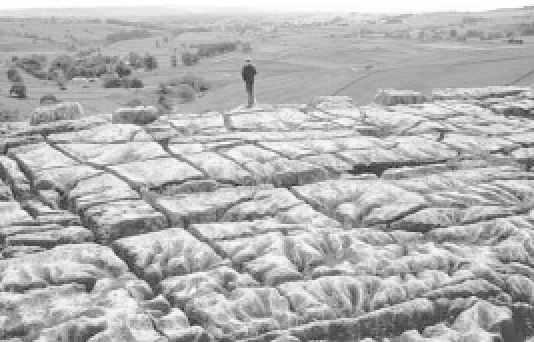Geology Reference
In-Depth Information
regularly (Lundberg and Ford 1994). Lesser pavements
occur where waves, rivers in flood, or even sheet wash on
pediments do the scouring instead of ice.
Pinnacle karst
Pinnacle karst
is dominated by large
Spitzkarren
.In
China, a famous example of pinnacle karst is the Yun-
nan Stone Forest (Plate 8.4; Colour Plate 3, inserted
between pages 208 and 209). This is an area of grey
limestone pillars covering about 350 km
2
. The pillars
stand 1-35 m tall with diameters of 1-20 m.
Arête-and-
pinnacle karst
, which is found on Mount Kaijende in
Plate 8.3
Clints and grikes on 'textbook' limestone
pavement on the lip of Malham Cove, Yorkshire. Towards
the cliff edge, the soils have always been thin; the grikes are
simple linear features and the clints show little dissection.
In the fore- and middle-ground, grike edges are rounded
and clints dissected by subsoil
Rundkarren
. The figure is a
young Paul Williams.
(
Photograph by Derek C. Ford
)
Polygenetic karst
Limestone pavements
Limestone pavements
are karren fields developed in
flat or gently dipping strata. They occur as extensive
benches or plains of bare rock in horizontally bedded
limestones and dolomites (Plate 8.3). Solution dissolves
clefts in limestone and dolomite pavements that are
between 0.5 and 25 m deep. The clefts, or grikes, sep-
arate surfaces (clints) that bear several solution features
(karren). A survey in the early 1970s listed 573 pave-
ments in the British Isles, most of them occurring on
the Carboniferous limestone of the northern Pennines
in the counties of North Yorkshire, Lancashire, and
Cumbria (Ward and Evans 1976).
Debate surrounds the origin of pavements, some geo-
morphologists arguing that a cover of soil that is from
time to time scoured by erosion encourages their forma-
tion. To be sure, the British pavements appear to have
been produced by the weathering of the limestone while
it was covered by glacial till. Later scouring by ice would
remove any soil cover and accumulated debris. It may
be no coincidence that limestone pavements are very
common in Canada, where ice-scouring has occurred
Plate 8.4
Pinnacle karst or shilin (shilin means 'stone
forest' in Mandarin) exposed in a road-cut in Shilin
National Park, Yunnan, China. The subsoil origin of the
pinnacles is plainly seen. Their emergence is due to the
general erosion of regional cover sediment.
(
Photograph by Derek C. Ford
)


